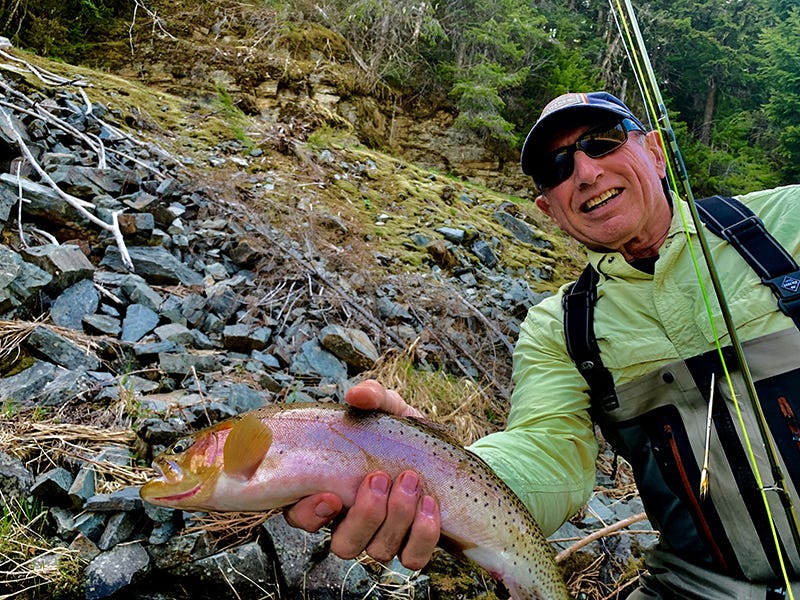Green Drakes on the Coeur d’Alene River

Western Green Drake Mayfly - The Start of Summer
The western green drake mayfly hatch is synonymous with North Idaho. Especially the North Fork of the Coeur d’Alene River. This hatch is, to me, the start of summer. When these bugs come off, it is impressive how the trout respond to them. They are a rather large mayfly and very hard for the trout to dismiss. The western green drake mayfly is not quite as big as the renowned Michigan mayfly, or properly Hexagenia Limbata, but close. They are a beautiful fly in shades of dark green and light yellow with mottled gray and black wings that stand tall. These aquatic bugs will start to hatch in May and continue throughout the first part of July here in North Idaho.

Typically, you will see them in bigger quantities in the middle of the day to late evening, and typically, cloudy days with little to no wind are best for these guys. Usually, by the time the bigger stoneflies like goldens and salmon flies start to peter out, you will see the green drakes start to show up. However, when these beauties start to show up, the trout will really key in on them.
Wonder what the current fishing conditions are? Read our latest fishing reports here.
Now, to be a little more specific there are a few different species of the green drake. Typically, the ones we see on the North Idaho streams are the larger variety called “grandis.” We will also see the smaller variety called “flav,” short for “Flavelenia.” These can be mistaken for a larger blue-winged olive or “beatis.” You’ll want to be safe and carry patterns in a parachute style like an olive parachute Adams. Plus, you’ll also want to carry patterns with a dark olive-green body in a size #8-10 for the big guys and #14-16 for the smaller variety. And, let’s not forget to have some variety in life stages too, such as an emerger, cripple, spinner, and nymph for fishing deep.
Read more about tying the Green Drake Floating Nymph here.
To be prepared during this hatch you should have a good selection of the different life cycle stages of this insect. One of my favorite setups is to have a large adult drake pattern for my lead fly and then a floating nymph pattern I like to tie. Quite often, these bugs will come off in the later part of the day. If the light is tough, it may be difficult to see an emerger pattern. So, running the floating nymph or emerger as the trailer fly behind a big dry will help you track that pattern in low light or choppy water. Plus, a big soft hackle style will suit the bill for this as well. Finally, be sure to have some spent spinner patterns too for when they die off.
Cutthroat have been notoriously picked on for being easy prey for fly fishermen. But during some of these specific hatches and conditions, I’ll beg to differ. You should be well armed with different sizes and life stages to fool these fish. For the subsurface pre-hatch conditions, use a larger pheasant tail nymph or a variety of specific nymph patterns to match. Try using a bigger pheasant tail nymph in a size #10-8 and then trail it with a bigger soft hackle emerger. At the end of all of your drifts always, and I mean always, “swing” it out. Your drift doesn’t always have to be a dead drift when nymphing. These bugs when actively hatching are strong swimmers and trout know this. Many trout have come to hand at the end of my drift with a nymph and soft hackle deep -same at the end of your dry fly drift.
Green Drake Cripple - A Staple Pattern
Next, a green drake cripple is also a staple pattern here in North Idaho. The Quigly cripple style green drake is a go-to pattern. At times, this pattern will get all the attention versus the adults for some reason. I think the trout know that they are more vulnerable than the adults or nymphs for that matter. Keep in mind, spinners are important too. The silhouette that the spent spinner throws to the trout is very distinct. When they are on the spinner, you better have this pattern or good luck.
Read more about tying the Green Drake Quigly Cripple here.
Having a diversity of patterns and understanding what to look for is important. Ask yourself, how are fish rising? Is it the classic toilet bowl rise with an air bubble left after the rise? If so, most likely they are eating the adults. Or, are they making a head to tail rise where you can see a slow roll? If this is the case, then they may be eating the emergers. Fish flashing under the surface close to the bottom means they are probably eating nymphs. And, how about a very splashy rise.? This could indicate a take on an emerger or possibly an adult taking flight. It pays to be very observant when the hatch is going. This can really tell you what you should be fishing. Take your time and watch rising fish to see any sort of repetitious pattern.

The green drake for many in North Idaho is their favorite hatch and time to be on the Coeur d’Alene. It signifies the time to get on the water for summer. I’d consider this more of a late spring bug but, again, it really says summer is here. Come into the shop this spring and let us help you pick out some of these awesome iconic bugs for your next trip.

